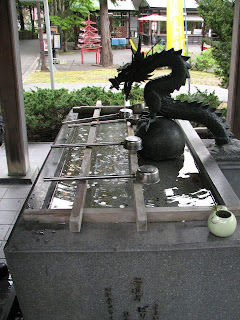
As we docked at the Aomori port the first thing you see is a strikingly beautiful bridge. The architecture in this city and Japan as a whole has been magnificent. Along the water as we disembark was a beautiful park with grass and trees allowing me to get 2 more life birds, the Oriental Cuckoo and the Long-tailed Rose Finch.
I made my way through the city headed to the Japan Rail Building hoping to explore some of the sites nearby. I wanted to see the Sannai-Maruyama Site or go to the Great Buddah (Showa Daibutsu).
The Sannai-Maruyama is a National Historic Treasure containing ruins dating back to 4000-5500 years ago (How old is the United States?). Today, archeologists are excavating more of the site and finding artifacts and clues to how the people lived at that time.
I made my way through the city headed to the Japan Rail Building hoping to explore some of the sites nearby. I wanted to see the Sannai-Maruyama Site or go to the Great Buddah (Showa Daibutsu).
The Sannai-Maruyama is a National Historic Treasure containing ruins dating back to 4000-5500 years ago (How old is the United States?). Today, archeologists are excavating more of the site and finding artifacts and clues to how the people lived at that time.

As I stood at the station, feeling confused, with no one speaking English, I saw a picture of the Buddha on a bus….as a result I hopped on, my decision was made. When I arrived at the site it was beautiful. The first vision was fields of rice in the midst of being harvested. The drying stalks looked nothing like rice but upon closer inspection you could see the kernels. Up the hill were many buildings including two Buddhist temples. I felt humbled when a Japanese woman came out with tongs and a bucket and picked the beetles gently up to return them to the woods. They do practice what they preach. The grounds were as I would expect from a Japanese garden with statues, a waterfall, wells, a large bell and many places to sit and be reflective. As I walked up the path, what I had come to see, came into view. On the hillside sat the Showa Daibutsu and my breath was taken away. The Great Buddha was more than two stories tall sitting in a lotus flower with hands held in a Zen meditation hand gesture. Much to my delight I could enter the Buddha in the back to go inside. After removing my shoes I stepped into a round hall completely filled with Buddhist proverbs and art. This was a wonderful collection and the place felt so spiritual. I then made my way to the second floor where I rubbed the belly of the Buddha from the inside out; I then took a moment to light some incense and say a prayer. What a great experience, one that I will never forget.
The captain and crew changed the itinerary due to hurricane Malor. It was to be a direct hit on Tokyo when we were scheduled to arrive, better to stay in the safety of the Japan Sea.
Tomorrow we cruise to Kobe, Japan.




